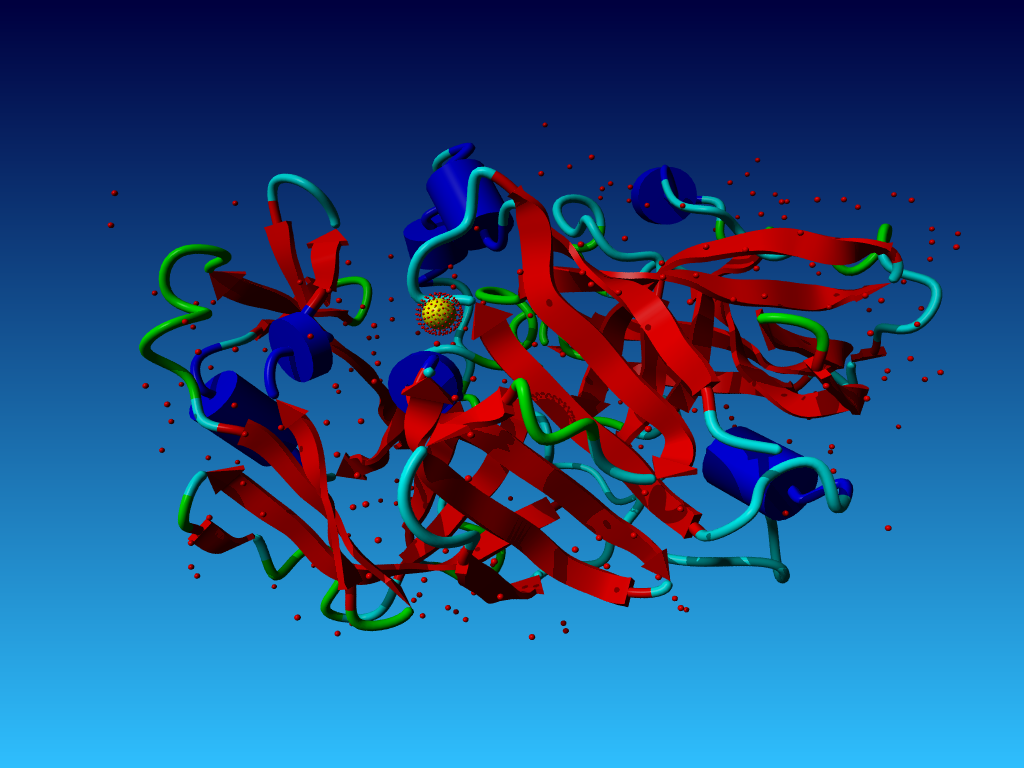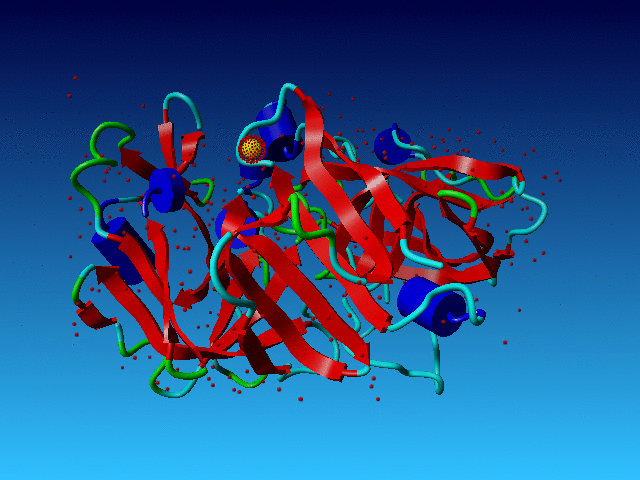
The structure of 1k7c. The very thin lines represent a layer of 10 Ångström of residues (etcetera) in symmetry related molecules. The waters were not shown for clarity.
The PDB gives no guidelines for the use of chain identifiers, other than that one is encouraged to use certain characters:
Only non-control ASCII characters, as well as the space and end-of-line indicator, appear in a PDB coordinate entry file. Namely:
abcdefghijklmnopqrstuvwxyzABCDEFGHIJKLMNOPQRSTUVWXYZ
1234567890
` - = [ ] \ ; ' , . / ~ ! @ # $ % ^ & * ( ) _ + { } | : " < > ?
We discourage use of punctuation characters in the place of alphanumeric
characters. The space, and end-of-line:. The end-of-line indicator is
system-specific. Unix uses a line feed character; other systems may use
a carriage return followed by a line feed.
|
However, a few rules-of-thumb have emerged over the years:
For the latter it is a pity that abc...xyz come before ABC...XYZ in the
ASCII code listed above. Because we normally start with the capitals and use
numericals and lower case characters "in case of emergency" only,
which for the lower case characters breaks rule of thumb number 2.
EU name: 1K7C
(Date: 2 Aug 24 2016 1K7C )
JRNL AUTH A.MOLGAARD,S.LARSEN JRNL TITL A BRANCHED N-LINKED GLYCAN AT ATOMIC RESOLUTION IN JRNL TITL 2 THE 1.12 A STRUCTURE OF RHAMNOGALACTURONAN JRNL TITL 3 ACETYLESTERASE JRNL REF ACTA CRYSTALLOGR., SECT.D V. 58 111 2002 JRNL REFN ASTM ABCRE6 DK ISSN 0907-4449 |
In the file 1k7c.pdb the protein has chain-id A; one of the sugars too. Most other sugars have chain-id B, but the sulphates and the waters have no chain-id at all.
Supplemental materialAdditionally, it is somewhat funny to see that the sugars are fully bound by symmetry related molecules. Normally the presence of sugars make crystallisation difficult, but in this case, it seems the sugars were important for forming the crystals.

|
The structure of 1k7c. The very thin lines represent a layer of 10 Ångström of residues (etcetera) in symmetry related molecules. The waters were not shown for clarity. |

|
The same situation, but now rotating to see things better... |

|
The structure again. The red NAG has chain-id A, just like the protein it is bound to. The yellow NAG, also bound to the protein, has chain-id B... |
In 1e4m everything (amino acids, PO4, Zn, has chain-id M, but the waters have chain-id
X. In 1MYP the sugars have a different chain-id from the residues they are covalently
bound to.
EU name: 1HTR
(Date: Aug 24 2016 1HTR )
REMARK 1 REFERENCE 1 1HTR 15 REMARK 1 AUTH P.K.IVANOV,M.CHERNAIA,A.E.GUSTCHINA,I.V.PECHIK, 1HTR 16 REMARK 1 AUTH 2 S.V.NIKONOV,N.I.TARASOVA 1HTR 17 REMARK 1 TITL ISOLATION, CRYSTALLIZATION AND PRELIMINARY X-RAY 1HTR 18 REMARK 1 TITL 2 DIFFRACTION DATA OF HUMAN PROGASTRICSIN 1HTR 19 REMARK 1 REF BIOCHIM.BIOPHYS.ACTA V.1040 308 1990 1HTR 20 REMARK 1 REFN ASTM BBACAQ NE ISSN 0006-3002 0113 1HTR 21 |
This file contains one very intruiging water.

|
In 1htr none of the water molecules has a chain-id, except for one that has chain-id B. Indicated as a red-dotted yellow sphere. |
Supplemental material

|
And here the structure is rotating around. No matter how I look at it the water with chain-id B remains an intruiging mistery. |